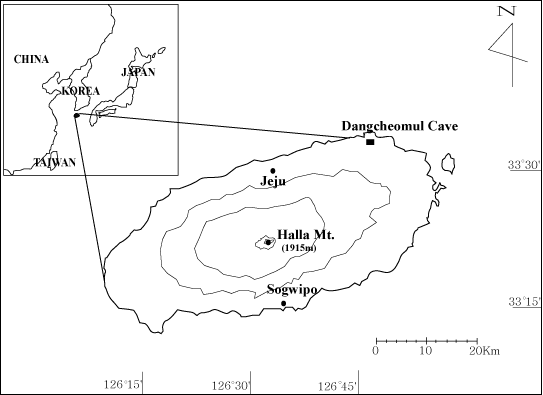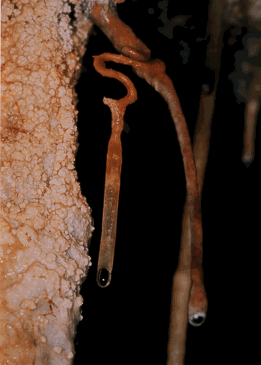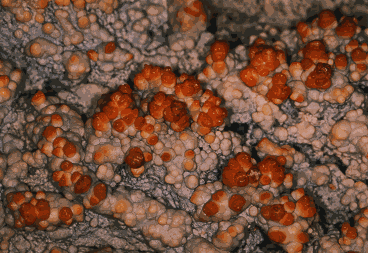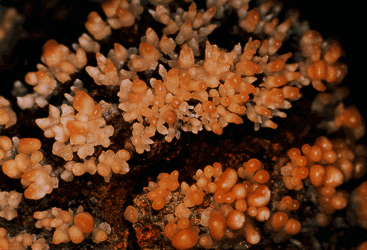Origin of Speleothems on a Lava Cave from Jeju Island, Korea
Abstract
Splendid speleothems are unusually developed on a small lava cave named "Dangcheomul Cave" on Jeju Island, Korea. The surface of the cave is splendidly decorated with various forms of calcite speleothems. The speleothems have been formed by precipitation of calcite from ground water draining downward through fissures and pores in the basalt ceiling. The carbonate type for the formation of speleothems resulted from dissolution of aeolian shell sands admixed with soils by acidic rainwater.

Figure 1. Location map of the Dangcheomul Cave in Jeju Island.
Introduction
The Dangcheomul Cave is a small lava cave unusually having beautiful speleothems. It is located on the flat land at 33°33'15"N and 126°47'15"E which is 16m above the sea level and 200 metres apart from the sea shore. It is one of many large or small lava caves which are scattered across the island, especially in the northeastern area. It was discovered during land development of the area in 1995.
The author investigated the cave in 1995 in order to evaluate its scientific importance (Kim, 1995). It has been registered as the Natural Monument No. 384 of Korea (Dec. 30, 1996). Scientific report of the Dangcheomul Cave was published by Bugjeju County (Son et al, 2000). It is not open to the public for its preservation. Therefore, it is not polluted and preserved in its original state.
Jeju Island
Jeju Island is located in 33°6' – 34°0'N and 126°9' – 126°58'E. It is 142km southwest from the main Korean peninsula. It has an elliptical form having long axis of 73km and short axis of 31km (Fig. 1).
Jeju island is a volcanic island of aspite type having a gentle slope over a large area. Halla Mt (1950m) is located in the center of the island and has a crater lake in its summit. The slope of the island is 3 – 5° in the east-west section and 5 – 7° in the north–south section.
The island consists mainly of basalt and basaltic tuff with minor andesite and trachyte, volcanic sedimentary formations and Quarternary aeolian shell sand formation. K/Ar dating suggests that the volcanic rocks in the coastal area erupted 0.70 - 0.41 million years ago (Ko et al).
Although the Korean peninsula has a distinct four seasons characteristic of temperate climate, Jeju Island has a semi-tropic climate in the low land having the annual mean temperature of 16°C, precipitation of 1388mm and relative humidity of 72%. About 43% of the total precipitation falls for three months from June to August.

Figure 2. Plan (a) and longitudinal cross section (b) of the Dangcheomul Cave.
Features on Dangcheomul Cave
Dangcheomul Cave is a small lava cave of 110m in length, 5.5 – 18.4m in width and up to 2.7m in height (Fig. 2). It lies below the 1.4 – 4.8m basalt cover. The cross sections of the cave are mostly flat arch in form. The bottom of the cave is roughly flat with a partial low pressure ridge. The original ceiling surface of the cave is nearly flat with partial small-scaled faults. The ceiling surface has small round-tipped lava stalactites, lava drips, and lava helictites.
The present surface of the cave is splendidly decorated with various forms of calcite speleothems such as stalactites, stalagmites, columns (Fig. 3), helictites (Fig. 4), straws, flowstone, rimstone, shelfstone, cave flowers, curtains, moon-milk, cave corals, cave corns (Fig. 5), egg-fry stalagmite, and cave pearls.

Figure 3. Stalactites and columns from the Dangcheomul Cave, Jeju Island.

Figure 4. Helictite, Dangcheomul Cave, Jeju Island.
All the calcite speleothems are white, light brown or brown in color. The straw stalactites usually have the shape of tubes within which water is filled. Some stalactites are developed around thin plant roots dipping down the basalt ceiling. There are various stalactites and stalagmites of curious forms. The brown corns on the creamy white cave corns (Fig. 5) show a beautiful color contrast. Small scalenohedral calcite crystals (dog-tooth spar) are also found (Fig. 6).

Figure 5. Brown cave corns on the creamy white cave corns from the Dangcheomul cave, Jeju Island.
The cave temperature, relative humidity and CO2 contents are different from place to place and from time to time at a given measurement time (Son et al, 2000). Such an environmental variation in the cave might be attributed to the influence of the outside temperature through the thin basalt roof of the cave.

Figure 6. Yellowish round cave corns and small calcite crystals (dog-tooth spar) from the Dangcheomul Cave, Jeju Island.
Genesis of Speleothems
Lava tubes and other volcanic caves usually have no speleothems. Where did the calcium carbonate for the formation of speleothems come from? It is certain that the groundwater precipitating speleothems drained through the thin basalt roof. Thus I surveyed the geology and soils of the cave area. It turned out that the soils on the surface consists mostly of shell sands and clays. It suggests that the calcium carbonate solution for the formation of speleothems have been formed by dissolution of shell sands in the surface soils by acid rain.
References
Kim, S. J., 1995: Scientific Value of Dangcheomul Cave as a Natural Monument. Cultural Heritage Office, ROK.
Ko, B. G. et al (unpublished data)
Son, I. S. et al., 2000: Report of the Scientific Investigation of the Natural Monument No. 384, Dangcheomul Cave. Bugjeju County.